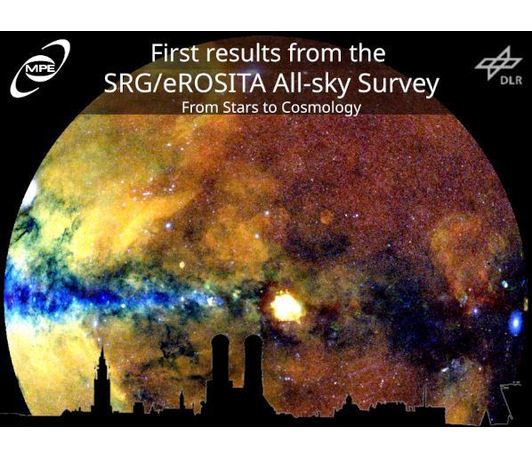First Results from the SRG/eROSITA All-Sky Survey: From Stars to Cosmology
eROSITA International Conference
- Start: Sep 15, 2024 09:00 AM (Local Time Germany)
- End: Sep 20, 2024 06:00 PM
- Location: Boltzmannstraße 15, Garching
- Room: HS1 Hörsaal/lecture hall 1, TUM
- Host: MPE/DLR

Scientific Rationale: In little more than half a century, X-ray astronomy has established itself as a fundamental domain of observational astrophysics. X-rays probe the hot and energetic components of the Universe, encompassing, among others, the million-degree coronae of stars, the remnants of supernovae, the ultra-dense matter in neutron stars, the immediate surroundings of black holes, the plasma filling galaxy clusters – the most massive objects in the Universe.
The new X-ray telescope eROSITA launched successfully on July 13, 2019, on board the Russian/German X-ray mission Spektr-RG (SRG). After commissioning and a successful performance verification program, eROSITA has started mapping the entire sky at unprecedented depths. Before being placed into safe mode on February 26, 2022, eROSITA completed 4.4 all-sky surveys. As in any other astrophysics domain, the eROSITA all-sky surveys unlock large swathes of discovery space, provide large statistical samples to study various classes of objects, and explore sufficiently large volumes to serve as cosmological tools for the study of the Universe as a whole.
Serendipitous scientific highlights include an X-ray flash from a nova, quasi-periodic eruptions, tidal disruption events, and the eROSITA bubbles. The high sensitivity, large field of view, and high survey efficiency of eROSITA are revolutionizing X-ray astronomy: The first all-sky survey in the Western Galactic Hemisphere includes more than 12.000 clusters of galaxies, 700.000 Active Galactic Nuclei, and 180.000 stars or compact stellar objects. This exceeds the total number of previously discovered celestial X-ray objects since the dawn of X-ray astronomy.
This
conference follows the public data release of the first all-sky survey,
which includes source catalogs of point-like and extended sources,
images, spectra, light curves, and X-ray photon events. We invite
presentations of the first scientific results driven by the
international community.
For more details (registration, scientific programme, etc.), please see
conference webpage!